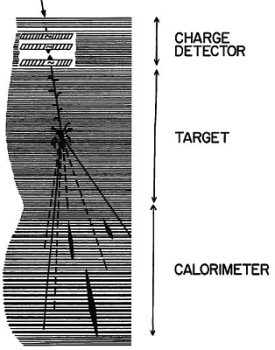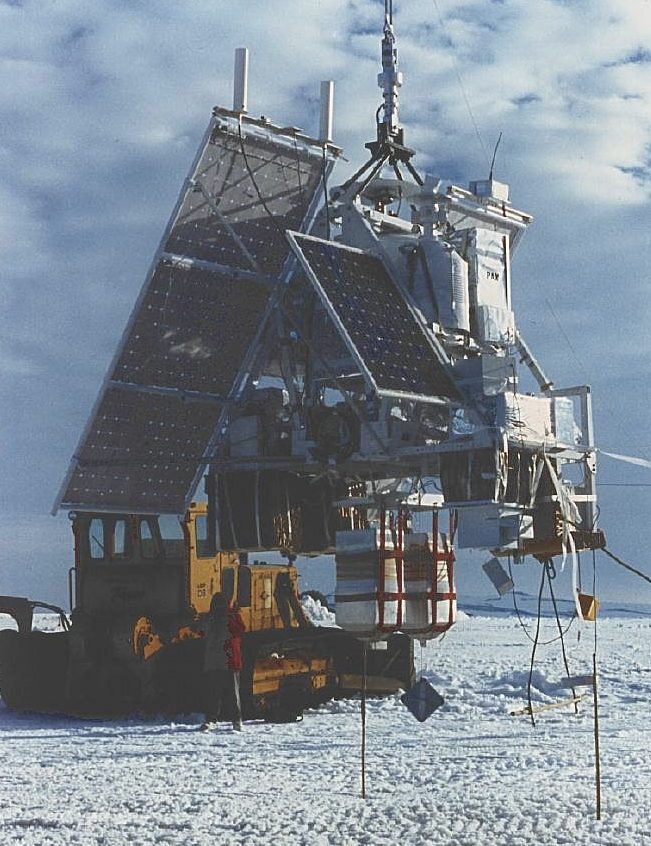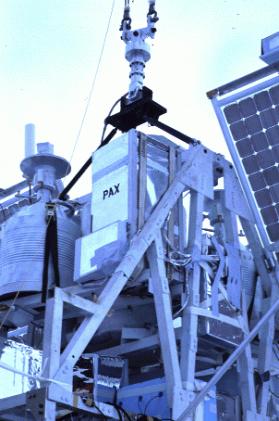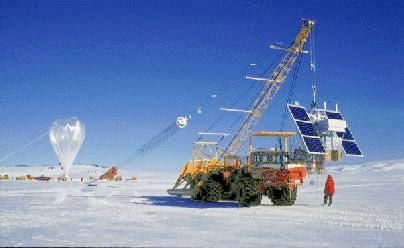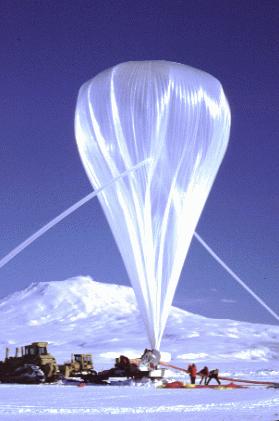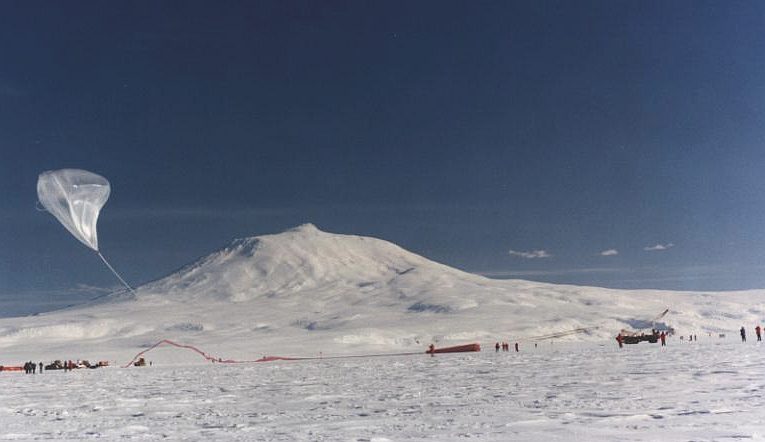Purpose of the flight and payload description
The Japanese American Collaborative Emulsion Experiment (JACEE) was a scientific effort carried out to measure the composition and spectra of primary cosmic rays at the top of the atmosphere, using emulsion chambers transported by stratospheric balloons. JACEE's first flight was conducted in 1979, and flights continued through 1996, totaling 14 flights and 13 successful missions. The collaboration leveraged Japanese expertise in photographic materials and microscopy, American expertise in ballooning and data analysis, and Polish resources in scanning and measurement of emulsions.
Each payload could contain one, three, or four chambers, each chamber with an area about 2000 cm2, 12~25 cm thick, and weighing ~120 kg. Figure at left shows a schematic diagram of the vertical configuration of one chamber. It was comprised of four sections, identifiable according to their function in the experiment. These are, from the top, the charge detector, the target, the spacer, and the calorimeter. All sections were multilayered stacks of track-sensitive materials (emulsions, x-ray films, CR-39, Lexan) alternated with absorbers (acrylic, lead). There were approximately 300 layers of emulsion in the chamber. This configuration was more or less the same for all the flights. However, many flights not included the spacer section, and in some cases were added other elements like Cerenkov detectors or plastic scintillators.
The charge detector employed thick (200 - 400 micron) emulsions, which permited accurate determination of the charge of each primary particle via measurements of the grain density, gap distribution, and/or delta ray distribution. The target section was comprised basically of thin (50 ~ 75 micron) emulsion plates alternated with acrylic sheets. The substantial mass of low-Z material maximized the interaction probability, while the emulsion optimized the observation of charged tracks from an interaction vertex. In order to identify nuclear fragments, charge identification layers composed of thick emulsions and etchable plastics were inserted at regular intervals throughout the target.
The spacer section consisted of honeycomb paper with a few thin emulsions positioned at regular intervals that facilitated the tracing of tracks through it. Finally, the calorimeter was the energy measuring portion of the apparatus. It consisted of 1.0 and 2.5 mm thick lead sheets alternating with thin emulsion plates and x-ray films. Gamma rays emanating from a vertex in the target initiated electro-magnetic cascades in the calorimeter. The cascades produced dark spots in the x-ray films, the observation of which provided the trigger for an event. The events were traced back from the calorimeter, through the spacer, to the vertex in the target by observing associated tracks in the emulsions.
For this, the first JACEE flight in Antarctica was important to compare the data obtained in the flight, with previous JACEE measurements for two reasons: first, to determine if background noise from the longer exposure and the lack of geomagnetic cutoff adversely affects the data; and second, to determine if innovations in post-flight analysis could had influenced the results. The detector array for JACEE-10 consisted of two 30 x 40 cm chambers of depth 6.6 radiation lenghts, smaller than the standard JACEE chambers in both depth and area.
Additional payloads
Due to the exploratory character of this first JACEE antarctic flight and the reduced size of the chambers used, spare room was available to share gondola space with other scientific groups which looking for long flight opportunities.
The first payload was PAX (Polar Auroral X-rays) a x-ray camera developed by a team of the University of Washington. It was a pinhole camera that used the Anger technique for imaging. The camera consisted of a collimator, a scintillator, and photomultiplier tubes (PMTs). It used seven hexagonally shaped PMTs tightly packed to view a single NaI(Tl) scintillation crystal and was shielded with an anticoincidence plastic scintillator to reject cosmic rays that contribute to background fluxes.
The second payload onboard was ANTIPODE (ANTartic Iron-isotope Phosphorus-Oxide glass DEtector) developed at the University of California, Berkeley. Basically it was a track-etch detector composed by ~100 stacks of sheets of a special barium-phosphate glass called BP-1 which was developed at UC Berkeley several years before. The detector was housed in a thermally regulated package, since the glass response depended on the temperature at the time of exposure. Several nuclei of iron and nickel in the galactic cosmic rays were detected.
Details of the balloon flight

Balloon launched on: 12/21/1990 at 18:50 utc
Launch site: Williams Field, McMurdo Station, Antarctica
Balloon launched by: National Scientific Balloon Facility (NSBF)
Balloon manufacturer/size/composition: Zero Pressure Balloon Winzen 29.470.000 cuft - SF3-424.37-080-NSCR-02
Balloon serial number: W29.47-2-12
Flight identification number: 303N
End of flight (L for landing time, W for last contact, otherwise termination time): 12/29/1990 at 11:29 utc
Balloon flight duration (F: time at float only, otherwise total flight time in d:days / h:hours or m:minutes - ): 8 d 17 h 39 m
Landing site: 113 miles SE of McMurdo Station, Antarctica
Gondola weight: 3500 lb
The balloon was launched by dynamic method with assistance of a special build launch vehicle on 21st December, 1990, from McMurdo station, Antarctica.
It continued it's flight for eight days in a radius of about 1000 miles around the south pole, at an altitude of about 25 miles above the ground, scanning a wide range of geomagnetic latitudes.
External references
- JACEE experiment website Institute of Nuclear Physics PAN, Poland
- A Measurement of the Isotopic Composition of Iron-group Elements in the Galactic Cosmic Rays PhD Thesis by Andrew J. Westphal, University of California, Berkeley, 1992
- Antarctic Balloon Flights for JACEE 24th International Cosmic Ray Conference, Vol. 3, Pag. 615
- Cosmic-Ray Proton and Helium Spectra: Results from the JACEE Experiment Astrophysical Journal Vol. 502 Pag 278, 1998
- Elemental abundance of high energy cosmic rays Nuclear Physics B - Proceedings Supplements - Vol. 60, Issue 3, p. 83
- Energy spectra and elemental composition of nuclei above 100-TeV from a series of JACEE balloon flights UWSEA PUB 94-07, Proc. 24th ICRC 2:707
- High-resolution spectra of 20-300 Kev hard X-rays from electron precipitation over Antarctica J. Geophys. Res., 100(A10), 19675-19685
- Images and energy spectra of an impulsive X-ray burst observed in the antarctic polar cap region Antarctic Journal of the United States, Volume 27, issue 5, pag. 301
- Long duration ballooning in Antarctica - An operational perspective AIAA International Balloon Technology Conference, Albuquerque, NM, Oct. 8-10, 1991
- NASA Balloon Flights (1989-1998) in NASA Historical Data Book, Vol. VII: NASA Launch Systems, Space Transportation, Human Spaceflight, and Space Science, 1989-1998
- Pinhole imaging of small-scale auroral x-ray structures Proc. SPIE 1744, Instrumentation for Magnetospheric Imagery, (1 June 1992)
- Pinhole x-ray cameras for imaging small-scaled auroral structures Opt. Eng. 32(12), 3164-3169 (Dec 01, 1993)
- Poor Man's 'Shuttle' Gathers Riches New York Times, January 1st, 1991
- Results from an Antarctic Balloon Flight 24th International Cosmic Ray Conference, Vol. 2, International Union of Pure and Applied Physics, 1995., p.752
- Scientific balloon circumnavigates Antarctica Goddard News Vol. 37 Nº 3, March 1991, pag. 8
- Search for Long-Mean-Free-Path Nuclei with a Balloon-Borne Emulsion Chamber 24th International Cosmic Ray Conference, Vol. 2, held August 28-September 8, 1995 in Rome, Italy
- Status of ANTIPODE and TREK Experiments 23rd International Cosmic Ray Conference, Vol. 1, P. 575
- The U.S. Max '91 program of flare research at the next solar maximum Advances in Space Research 8; 11, 1; 129
1525If you consider this website interesting or useful, you can help me to keep it up and running with a small donation to cover the operational costs. Just the equivalent of the price of a cup of coffee helps a lot.

